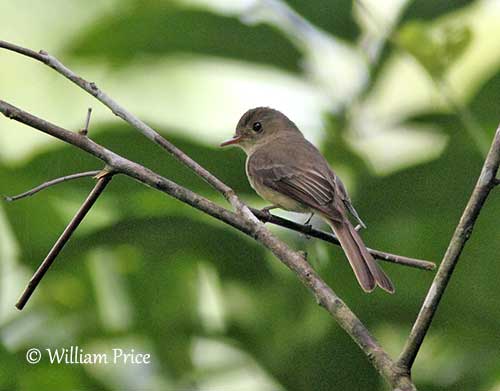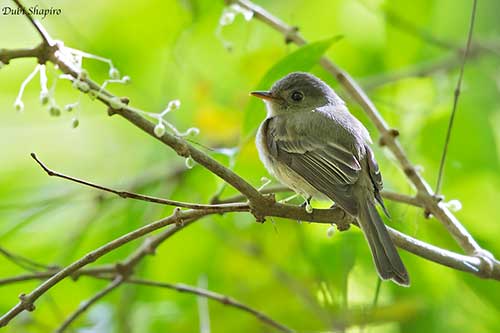Fr: Moucherolle de la Jamaïque
Ang: Jamaican Pewee
All: Jamaikaschnäppertyrann
Esp: Pibí Jamaicano
Ita: Piuì della Giamaica
Nd: Jamaicapiewie
Sd: jamaicapivi
Photographers:
William Price
PBase-tereksandpiper & Flickr William Price
Dubi Shapiro
Dubi Shapiro Photo Galleries & Dubi Shapiro's Pictures on IBC
Text by Nicole Bouglouan
Sources:
HANDBOOK OF THE BIRDS OF THE WORLD Vol 9 - by Josep del Hoyo - Andrew Elliot - David Christie - Lynx Edicions - ISBN: 8487334695
BIRDS OF THE WEST INDIES – by Herbert Raffaele, Kristin Williams et Tracy Pedersen – Helm – ISBN: 9780713649055
A Field Guide to the Birds of the West Indies by James Bond – Editeur: Houghton Mifflin Harcourt, 1999 – ISBN: 0618002103, 9780618002108 – 256 pages
A Photographic Guide to the Birds of Jamaica De Ann Haynes-Sutton, Yves-Jacques Rey-Millet, Audrey Downer, Robert Sutton – Editeur: Bloomsbury Publishing, 2010 – ISBN: 1408133229, 9781408133224 – 336 pages
Neotropical Birds – Cornell Lab of Ornithology
Jamaican Pewee
Contopus pallidus
Passeriformes Order – Tyrannidae Family
INTRODUCTION:
The Jamaican Pewee is endemic to Jamaica where it is generally common and widespread. It occurs at forest edges and in forests from mid to high elevations.
It feeds on insects caught by sallying from exposed perch. It nests in a cup-shaped structure placed in tree fork.
The Jamaican Pewee has restricted range in which it is vulnerable to habitat destruction, but currently, it is not globally threatened.
DESCRIPTION OF THE BIRD:
Biometrics:
Length: 15 cm
Weight: 9-9,5 g
The Jamaican Pewee is a small Tyrannidae. The upperparts are dark olive-brown, with dark brown wings showing two pale, indistinct, narrow wingbars. The long tail is mostly dusky brown and slightly notched.
The underparts are buffy-brown, but the throat is greyer. Breast and body sides are tinged olive, whereas the undertail-coverts are buffier.
On the head, the crown is darker than the upperparts.
The broad, two-tone bill has black upper mandible and yellow lower one, with well-developed rictal bristles. The eyes are dark brown. Legs and feet are blackish.
Male and female are similar.
The juvenile is greyer above, but below, the breast is paler. The narrow wingbars are cinnamon. The bill is paler than in adults.
RANGE:
The Jamaican Pewee is found only in Jamaica.
HABITAT:
The Jamaican Pewee frequents mainly forests at mid-elevations, whereas it is less often in high mountain forests. However, it can be seen at forest edges. The species is visible up to 2,000 metres of elevation.
CALLS AND SONGS: SOUNDS BY XENO-CANTO
The Jamaican Pewee gives a plaintive “pee” at variable tones. During the day, we can hear an “oéeoh” first rising and then falling.
The dawn song includes two alternating phrases “paléet, weeléeah”.
BEHAVIOUR IN THE WILD:
The Jamaican Pewee is an insect-eater. It catches the prey in the air by sallying from exposed perches. It often forages between 2 and 9 metres above the ground, but probably much higher too.
It performs horizontal sallies and regularly moves from perch to perch within its territory.


The Jamaican Pewee breeds mainly in forests and nests in a cup-shaped structure placed in tree fork.
This species is resident in Jamaica, but it performs some altitudinal movements and reaches lower elevations and lowlands outside breeding season.
The flight is easy and agile while the bird is foraging and performs acrobatic manoeuvres when pursuing insects in the air.
REPRODUCTION OF THIS SPECIES:
The breeding season takes place from April to June.
The Jamaican Pewee breeds at high and mid-elevation forests and may produce two broods.
The cup-shaped nest is made with finely woven plant materials including fibres, grass and Spanish moss (Tillandsia). This small structure is usually placed in tree fork.
No other information.
PROTECTION / THREATS / STATUS:
The Jamaican Pewee has restricted range in which it is common and widespread.
The species is vulnerable to habitat loss, through forest clearance. Some forested areas are protected, but hunting and destruction continue.
Second growths are also cleared for coffee and pine (Pinus) plantations. Hurricanes, use of pesticides, fires and conversion for farming and urbanization involve the decline of the population.
But currently, the Jamaican Pewee is not globally threatened and the species is evaluated as Least Concern.